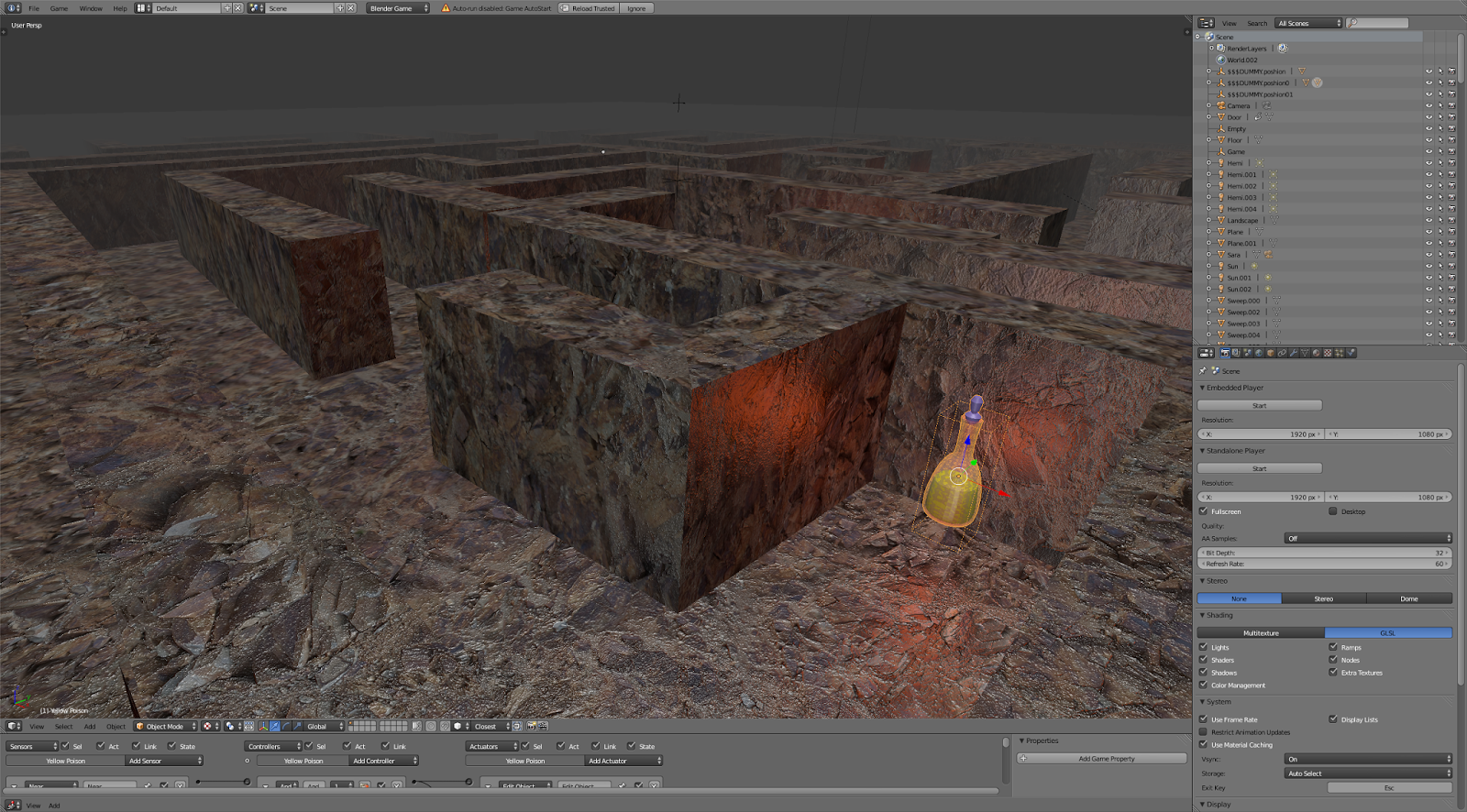Homework 7
Is the
space in your game discrete or continuous?
·
Discrete
How many
dimensions does your space have?
·
Tree dimensions
What are
the boundaries of your space?
·
The walls in the Maze in relationship with to the outside world
How many
verbs do your players (characters) have? What are they?
Jump,
Run, Kill and open doors
How many
objects can each verb act on? What are these objects?
Potions
can be use in multiple ways:
·
Purple allow you walk through walls for a few seconds
·
Red increase your strength for a few seconds
·
Blue Makes you jump higher
Sword
& Spears:
·
Kill monsters
·
Open lock doors
·
Break walls
How many
ways can players achieve their goals
·
Goals in the game can be achieved in multiple ways, players have to look for
unusual interactions and interesting combinations of Potions and other items
strategizing to find and exit. The Maze is very intricate and has only one exit
but multiple ways to get to it.
How many
subjects do the players control? What are these subjects?
The many
subjects in the game can interact with one another, to form new solutions. For
example by coordinating different combinations of potions or sacrificing health
in certain cases the player could pass thought a monster in a narrow corridor.
How do
side effects change constraints?
·
Every time you obtain a potion or weapon, you not only change the monsters
behavior, but you simultaneously change which reaction the monster will now
have given that you activate the weapon or potion. My plan is to program a
basic AI into the antagonist in the game to make the game more interesting.
What are
the operative actions in your game?
•
Move character free in all directions
•
Jump obstacles
•
Move in and out of doors
What are
the resultant actions in your game?
•
Protect a Sara from being captured by monsters
•
Sacrifice health to pass through a monster
•
Move a Sara into the safe room to avoid monsters
•
Use Spear, sword or potion to kill Monsters
What
actions would you like your players to do that they cannot presently do? (based
on your current knowledge of Blender)
I would
like to be able to program elegant artificial intelligence to the monsters in
the game, so they can react to the player actions.
What is
the ultimate goal of your game?
To find
an exit to the Maze
Are there
short and long term goals? What are they?
The short
term goals are to collect a series of items to increase the player score and
health. The long term goals are to find the exit to the Maze, while managing to
fight your way out without getting harm or kill by the monsters in the level.
How do
you plan to make the game goals known and understood by the player?
Sings in
the form mini tutorials would appear anytime a new action needs to be performed
for the first time. This would be triggered by near sensors.
What are
the foundational rules of your game?
Exploration
and item collection
How are
these rules enforced?
·
If the player finds the right items hidden in the level, this event would
triggered momentary immunity to monsters allowing them to pass, If not this
will equal dead. This makes an achieved goal rewarding. Physical constraints of
the game world would simplify and enforce the rules, while also allowing gamers
to avoid memorizing complex actions.
Does your
game develop real skills? What are they?
·
The real skills of this game are problem solving and spatial awareness. By
having to doge the monsters and try finding the exit, a repeating cycle of an
increasing challenge factor is presented followed by a reward, often increasing
the player’s powers an giving easier periods of less challenging events. This
design is based on the book of lenses curve flow chart that feels much more
interesting to a player.
Does your
game develop virtual skills? What are they?
·
The character’s skill level would increase when finding a series of assorted
magical objects in the game. Spears, swords and various magical potions would
gradually increase the players ability to fight monster in the game by which in
this context, refers to a virtual skill that the player would pretend to have.
My
contributions to the team:
What I
have done for the team four this week include, allocating a series of libraries
base on advance MOCAP file animations from the University of Oregon in order to
make the lead character walk and be presented in an intro cut scene in HD which
I believe would increase and elevate the level of realism in the game.
In
addition to that I research and created a series of realistic UV textures and
made normal maps and displacement maps to be use in the game which would allow
the game engine to render GLS in a more realistic way. Combining Blender UV
mapping with a program called Crazy bump I generated more realistic textures
giving our game a visual edge in graphics.











